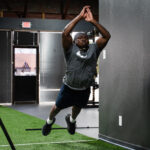Why Youth Athletes Need Sports Performance Training
Today’s young athletes face more competition than ever. Whether they play soccer, baseball, basketball, or run track, performance expectations keep rising. That’s why sports performance training is essential—even for youth athletes.
Proper training helps kids build strength, prevent injuries, and perform better—all in a safe and age-appropriate way. Let’s explore how young athletes benefit from sports performance training and what parents need to know.
What Is Youth Sports Performance Training?
Youth sports performance training is a structured fitness program designed for growing athletes. It focuses on:
-
Age-appropriate strength
-
Speed and agility drills
-
Balance and coordination
-
Injury prevention
-
Confidence building
Unlike adult training, youth programs emphasize movement skills, not heavy lifting. The goal is to develop athletic ability while protecting the body during key growth stages.
With guidance from trained coaches, kids learn proper technique and build a foundation for long-term success.
Builds Athletic Foundations Early
The earlier kids develop basic movement skills, the better. Sports performance training introduces:
-
Running mechanics
-
Jumping and landing
-
Balance and coordination
-
Agility and footwork
These foundational skills apply across all sports. A child who moves well is more confident and less likely to get injured.
Training also helps develop body awareness and control—key skills for both performance and safety.
When young athletes train consistently, they gain an advantage in their sport as they mature.
Encourages Safe Strength Development
Some parents worry that strength training might harm a child’s growth. But when done correctly, it’s very safe.
In fact, the Healthline guide on exercise for kids explains that resistance training supports muscle development, bone health, and overall fitness.
Youth sports performance training uses:
-
Bodyweight exercises
-
Resistance bands
-
Medicine balls
-
Light dumbbells (when appropriate)
These tools allow for strength gains without heavy loads. Coaches also focus on form and technique to avoid injury.
Over time, young athletes build lean muscle, improved posture, and better overall function.
Improves Speed, Agility, and Coordination
Speed and agility are critical in nearly every youth sport. Sports performance training uses fun, challenging drills to improve these skills:
-
Agility ladders
-
Cone drills
-
Reaction games
-
Short sprints
These exercises help kids move more efficiently and stay balanced during quick movements.
Improved coordination makes it easier to pick up complex sport techniques later on—like dribbling a ball or performing gymnastics routines.
The best part? These drills often feel more like games, keeping kids engaged and excited.
Reduces the Risk of Injury
Young athletes are prone to overuse injuries, especially when they play one sport year-round.
Sports performance training combats this with:
-
Balanced muscle development
-
Flexibility work
-
Core strengthening
-
Proper warm-ups and cooldowns
Programs are designed to prepare the body for the demands of sports. For example, strengthening the hips and glutes supports the knees, reducing ACL injury risk.
At Next Level Athletics, coaches design training plans that protect young athletes and prepare them for long seasons.
By teaching good movement habits early, training reduces injuries both now and in the future.
Builds Confidence and Mental Toughness
Sports performance training isn’t just physical—it’s mental too.
Through consistent training, youth athletes:
-
Learn discipline
-
Set and achieve goals
-
Build self-esteem
-
Overcome challenges
These lessons go beyond the field or court. Kids who train regularly often perform better academically and socially.
They also gain the confidence to compete, recover from mistakes, and keep trying.
This mental toughness is one of the biggest long-term benefits of youth training.
Supports Long-Term Athletic Development
Rushing performance at a young age can lead to burnout or injuries. That’s why training should focus on long-term development rather than quick wins.
Sports performance training follows age-appropriate progressions. Young athletes learn movement now and add intensity later.
By the time they reach high school or college, they’re stronger, safer, and more prepared than peers who didn’t train.
It’s a smart investment in a child’s athletic journey—and their overall health.
Tailored for Each Kid’s Needs
No two youth athletes are alike. One may need help with coordination, while another is ready to build speed.
Sports performance training adapts to each child’s:
-
Sport
-
Age
-
Body type
-
Fitness level
-
Training experience
Custom programs make training more effective and enjoyable.
Whether your child plays multiple sports or focuses on one, training can support their specific goals.
Conclusion: Help Young Athletes Thrive with the Right Training
Youth sports performance training gives kids a head start. It helps them move better, stay safe, and build confidence that lasts a lifetime.
By starting early, young athletes learn proper form, gain strength, and improve coordination—all while having fun.
Most importantly, it sets them up for success on and off the field.
If you’re looking to support your child’s athletic journey, consider a professional training program that meets them where they are—and helps them grow from there.


Recent Comments